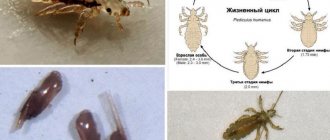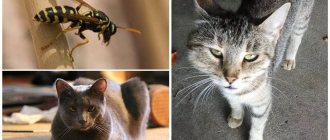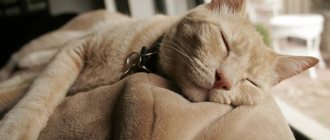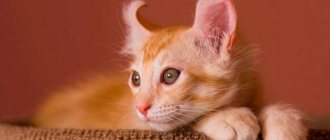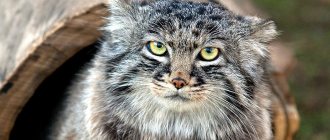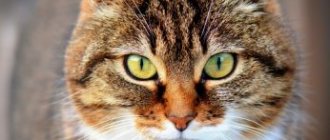INTERESTING: the closest relatives of the Amur forest cat are the Amur tiger and the Far Eastern leopard.
The first mention and description of the species dates back to 1871 and is associated not with the interest of naturalists, but with the fur trade. The same factor played a cruel joke on the population - beautiful fur led the population to critical status. Now the Far Eastern forest cat is listed in the Red Book, and its population size is estimated at only 2,500 individuals.
What does it look like?
The Amur cat looks like the familiar domestic cat, although it belongs to a different subspecies. The length of its body is about 90 cm, almost half of which is the tail. Female animals are smaller than males, their body weight does not exceed 4 kg. Males, in turn, weigh approximately 8 kg. The inhabitant of the Far East boasts a muscular and flexible body, long limbs, a small head on which rounded ears are located. There are also such notable features:
- The eyes are close and deep-set.
- There is a stripe running down the middle of the nose, which is practically not covered by fur.
- The claws are short, and the fangs, on the contrary, are long.
Animal color
The color of the fur of the cubs of such an animal is close to leopard.
The Amur cat has a thick undercoat and soft fur. The color is gray-sand or yellow-brown. The body is decorated with red spots, which form 3 stripes on the back. They are also located on the limbs and throat. Kittens are more reminiscent of a leopard; in older individuals, the coloring becomes more even. The fur on the belly is lighter than on the back. There are also stripes on the head that start from the inner corners of the eyes. Thanks to this color, wild cats can hide unnoticed both on the ground and in trees.
Lifestyle and nutrition
The Far Eastern forest cat leads a solitary life, gathering in groups of several individuals only during the mating period. One individual usually covers 4-9 km²; it does not leave this territory and guards the boundaries of its property. Migrations occur only in the absence of the proper amount of food.
Within its territory, the cat has several shelters, which are rock crevices hidden from prying eyes by thickets of bushes, abandoned badger and fox holes, and hollows of old trees. In favorable times, the animal periodically visits all its makeshift homes, but for the winter it remains in the warmest and most protected one.
During periods of prolonged snowfall, the Amur cat may not leave its home for weeks, waiting for the weather to improve and crust to form. Their paws are not adapted to move on loose snow, and their modest size makes this activity almost impossible.
They begin to hunt at dusk, waiting for prey in ambush on a tree or in the bushes. Surprisingly, a Far Eastern cat only needs one precise jump to overtake an unfortunate mouse or squirrel.
The diet of this predator consists of small mammals such as hares, chipmunks, and mouse-like rodents. The forest cat also hunts birds, often destroying their nests and feasting on eggs. Sometimes it attacks small ungulates - young roe deer and deer, and catches fish.
In addition to the above, the Amur cat can eat frogs and other amphibians, as well as insects. He does not disdain the remnants of the feast of his larger brothers - the leopard or the tiger.
The lifestyle and character of the Far Eastern forest cat have been little studied, since this animal is very secretive and tries to avoid human habitation. However, in particularly harsh winters it can come close, trapping rodents in barns and stealing poultry.
In case of danger, the Amur cat hides in a tree, but if a skirmish cannot be avoided, it defends itself very fiercely and does not retreat, even if the enemy surpasses it in size and strength.
Reproduction
According to some sources, Amur cats reach sexual maturity at the age of 8-10 months, according to another version only at 1.5 years. As expected, the breeding season of the leopard cat is in March. Some experts claim that these animals are monogamous, although this is not typical for cats.
If two gentlemen are courting a female, skirmishes and fights between them cannot be avoided. Fights are accompanied by hissing and wild screams, the winner gets the right to mate and procreate, the loser leaves.
Kittens are born after 65-70 days, usually 1-2, less often 4. Newborn kittens are blind and helpless, their weight is only 70-80 g. At first, they spend most of the day sleeping, waking up only to eat. Both parents look after the babies. The female is constantly on the alert, and sensing the slightest danger, she takes them to another place.
Kittens grow quickly and already at 1.5 months they get out of the shelter to explore the surrounding area. Young cats do not stay near their mother any more than necessary. At the age of 6-7 months, they finally leave their parents’ den and go in search of their own hunting grounds.
How does it reproduce?
The Far Eastern cat is accustomed to leading a solitary lifestyle. However, with the onset of autumn, he begins to look for the female, calling her with a abrupt and loud growl. The duration of pregnancy is no more than 70 days. At the end of spring, the female brings offspring. The Ussuri kitten is born blind, its weight does not exceed 100 g. Its eyes open 2 weeks after birth. After 2 months, the kittens leave the nest and explore the territory under the supervision of the female. The father of the family also raises the offspring. After six months, the kittens leave the nest and find their own territory where they will live and hunt. Far Eastern cats reach adulthood after 1 year of life. Its duration is on average 10-12 years.
Number
The name of this animal is in the Red Book.
Far Eastern cats are incredibly secretive and cautious, so scientists have not yet been able to carry out even an approximate count of them. Despite this, not so long ago the animals were listed in the Red Book. Some are convinced that this is connected with hunting cats, but this opinion is not true. The species is in danger of extinction, as there are fewer and fewer areas suitable for their existence. In addition, burning of last year’s leaves, which is carried out every year, also poses a danger to these predators.
The Far Eastern cat is not dangerous to humans. Despite this, in the USSR it was classified as a lynx and a wolf, which could harm people. In this regard, the Amur cat was often killed for no reason in order to receive a monetary reward from the village council. Hunting for the animal was not carried out in Russia, since its fur is not of particular value. However, in the People's Republic of China it was hunted for its fur. Nowadays, killing these cats is punishable by law.
Amur forest cat in captivity
The Far Eastern forest cat is kept in some zoos, but even with everyday interaction with people, it is absolutely not amenable to domestication. They reproduce well in captivity, but they are always wary of humans.
Forest cats are fed once a day with live small rodents and birds. The life expectancy of the Amur cat in the natural environment is 8-10 years, in captivity up to 17 years.
At home, the Amur forest cat can only be kept in a spacious enclosure. Even if you take a kitten 3 months old and raise it in a family, the animal will pose a danger as an adult. Particularly aggressive behavior is observed in cats during periods of acute sexual desire.
Status and protection
The Amur forest cat is listed in the Red Book of the Russian Federation and is protected by the international CITES Convention as an endangered species. Nowadays, according to researchers, the population of wild cats has begun to grow.
In our country, Far Eastern cats inhabit several biosphere reserves:
- Cedar Pad (Primorsky Territory);
- Khankaisky (Primorsky Territory);
- Ussuriysk (Primorsky Territory);
- Lazovsky (Primorsky Territory);
- Bolshekhehtsirsky (Khabarovsk Territory).
The main threat to cats in the Far East is the reduction of natural habitats due to deforestation. Another important factor is the possibility of crossing with an ordinary domestic cat, as a result of which the genetic purity of the species is lost.
Habitats
The Amur forest cat, like many other inhabitants of the Far East, is endemic. It is not found anywhere else. This predator inhabits the entire length of the Amur River, on the coast of the Sea of Japan, in the area of lakes Khanka and Khasan, on the Hindustan Peninsula, as well as practically throughout the entire territory of China up to the Malay Islands.
He feels especially comfortable in nature reserves: Khankaisky, Ussuriysky, Lazovsky, Kedrovaya Pad. This is explained not so much by safety (the Amur cat has never been hunted on an industrial scale), but by the distance from human settlements.
This predator is also found on some of the Japanese islands. In fact, this is where one of its names came from: “Leopard Cat of Tsushima.”
It lives mainly in grassy floodplains, deciduous or mixed forests. It is less common in the taiga, although even there you can see its spotted skin. In Pomorie, its main habitat is shrubs and reed lowlands along the banks of oxbow lakes and lakes. In these places you can often find the name “reed cat”: it is not entirely correct, since a completely different representative of the cat family has the same name, but it well reflects the lifestyle of the Amur predator.
The Far Eastern cat feels quite confident on the rocks, although it does not climb high into the mountains. The reason for this is the snow that accumulates between the stones in winter (the maximum depth of snow cover at which a predator can hunt is 30-40 cm).
With the beginning of winter, the cat hides in the nest and does not leave it until a strong frozen crust forms on the surface of the snow, capable of supporting the weight of the animal. The only exceptions are cats feeding their cubs, and those of their cats who were unlucky in hunting before the blizzard.

